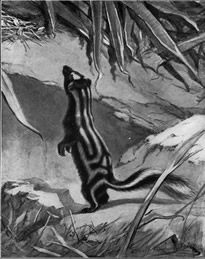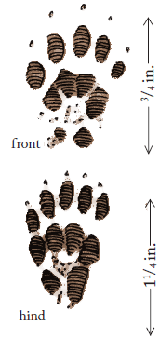Wildlife - Species

Species Specific Regulations
Eastern Spotted Skunk
Licenses: Hunting License required.
Limits: Weapon restrictions according to game zones please check for Limitations.

Spotted Skunk tracks
Spotted Skunk (Spilogale putorius)
Description
Skunks are stout, short-legged animals. They are very distinctive with a long coarse pelage of sharply contrasting black and white patterns. Spotted skunks have 4 to 6 white stripes starting at the head and breaking up into spots near the rump. Both species of skunks have long sturdy claws for digging and possess well-developed musk glands for defense.
Average Size
Spotted skunks, weighing 1 to 4 pounds, are smaller than striped skunks.
Life Expectancy
Approximately 2-6 years
Preferred Habitat
Skunks use a variety of habitat types, preferring woodlands, semi-open farmland, and old abandoned fields. They are often found around farm yards, and their habit of denning under farm buildings and homes causes some problems. In forested areas skunks den in rock piles and under the roots of blown-down trees, or they use their well-developed claws to dig a den in the side of a bank.

Range
The spotted skunk is not found in New England or the north-central states. Spotted skunks are less common and occur most frequently in the highlands of the state.
Food Habits
Skunks are omnivorous in their feeding habits. Insects are very important particularly for striped skunks. Other animal matter eaten includes mice, rats, frogs, salamanders, small birds, and eggs. Fruits, berries, and grains supplement the diet in the summer months.
Reproduction
Peak Breeding Activity
Spotted skunks breed in April.
The average spotted skunk litter size is 3 to 5. The young of both species are born blind and are not weaned until 8 to 9 weeks of age. Family units stay together until fall
Gestation
45 to 65 days and the average litter size is 3 to 5.
Miscellaneous
Skunks are preyed upon by owls, hawks, and, to a limited extent, by dogs, bobcats, and coyotes. Most mammalian predators are repulsed by the skunk’s odor. Skunks are highly susceptible to highway mortality, and are affected by a variety of diseases including rabies, distemper, and tularemia.
Traditionally, skunks were classified by taxonomists in the Mustelidae family and frequently listed in the subfamily Mephitinae. More recently, however, skunks have been classified as the separate family mephitidae.
Little is known about the early abundance and distribution of striped and spotted skunks in South Carolina. Today, skunks are common in the Piedmont and Foothills regions, and populations may be quite abundant in local areas within these regions. Below the fall line, skunks are uncommon and their occurrence is spotty. As a furbearer, skunks receive little attention from a commercial standpoint. Pelt values have ranged from $1.00 to $5.00 in recent years. Most skunks are harvested by trappers incidental to trapping for other furbearer species.
Publications and Literature
Baker, O.E., Carmichael, D. Breck, South Carolina Furbearers. Wildlife and Freshwater Fisheries Division. Columbia, South Carolina
Fur Harvest Hunting and Trapping are provided in the Fur Harvest Brochure which is a summary of the state statutes regarding the commercial harvest of furbearers. Applicable statutes are listed in parentheses at the end of each section of this brochure. Copies of actual statutes of the SC Code of Laws are available online from the SC Legislature at www.scstatehouse.gov or by writing: Furbearer Program, SC Department of Natural Resources, P.O. Box 167, Columbia, SC 29202.
Some of the files above are provided in the Adobe® Acrobat® (PDF) format. Adobe® Reader® is required to open these files and is available as a free download from the Adobe® Web site.
Jay Butfiloski - Furbearer Project Supervisor
SCDNR Furbearer Project
P. O. Box 167
Columbia, SC 29202-0167
Phone: 803-734-3886
Fax: 803-734-6020
E-mail: ButfiloskiJ@dnr.sc.gov
